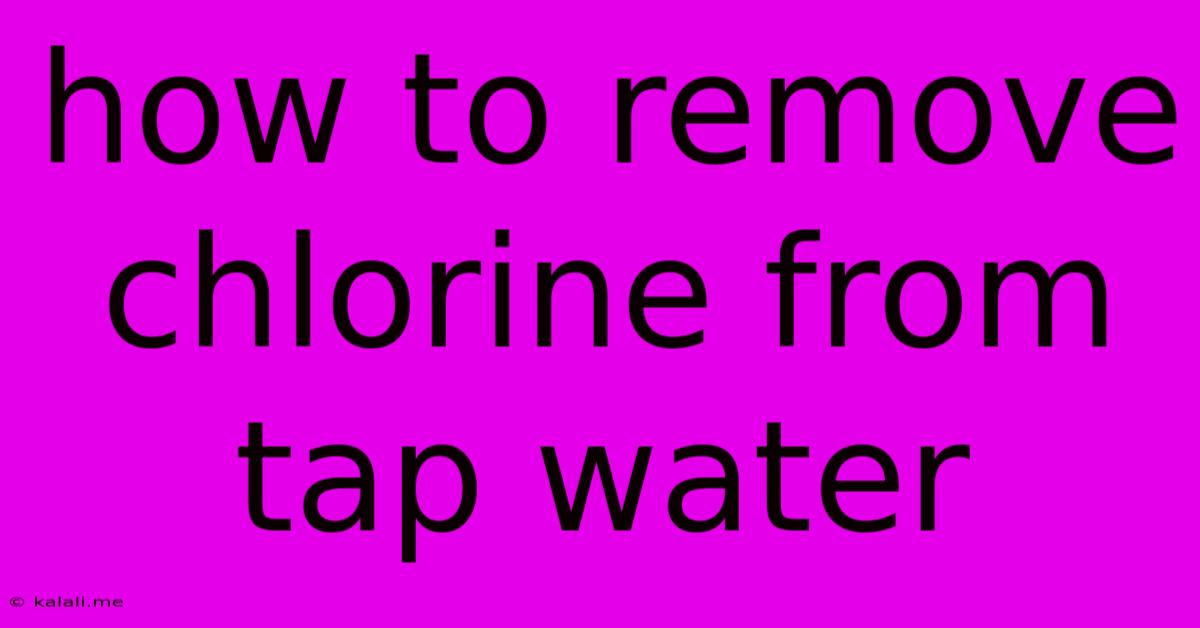How To Remove Chlorine From Tap Water
Kalali
May 27, 2025 · 3 min read

Table of Contents
How to Remove Chlorine from Tap Water: A Comprehensive Guide
Chlorine is added to tap water to kill harmful bacteria and viruses, ensuring its safety for consumption. However, some find the taste and smell of chlorine unpleasant, and others worry about its potential long-term health effects. If you're looking to remove chlorine from your tap water, several methods are available, ranging from simple home techniques to more advanced filtration systems. This guide explores the most effective options, helping you choose the best method for your needs and budget.
Why Remove Chlorine from Tap Water?
While chlorine effectively disinfects water, it can impart an undesirable taste and smell, making it less palatable for drinking or cooking. Some people are also sensitive to chlorine and experience skin irritation or other adverse reactions after prolonged exposure. Additionally, some believe that removing chlorine can improve the taste of coffee and tea, enhancing the overall beverage experience. Finally, removing chlorine might be important for those who keep fish or other aquatic life sensitive to chlorinated water.
Methods to Remove Chlorine from Tap Water:
Here are several methods to effectively remove chlorine from your tap water:
1. Boiling:
- How it works: Boiling water for at least one minute volatilizes chlorine, allowing it to escape into the air. This is a simple and readily available method.
- Pros: Simple, inexpensive, and readily available.
- Cons: Doesn't remove other contaminants. Boiling reduces water volume, and prolonged boiling can lead to mineral buildup.
2. Aeration:
- How it works: Pouring water from a height into a container or using a fountain significantly increases the surface area, allowing chlorine to dissipate into the atmosphere.
- Pros: Simple and inexpensive.
- Cons: Doesn't remove other contaminants. Effectiveness depends on the amount of chlorine present and the aeration method.
3. Activated Carbon Filtration:
- How it works: Activated carbon filters are highly porous and effectively adsorb chlorine molecules, removing them from the water. These filters are commonly found in water pitchers, faucet attachments, and whole-house filtration systems.
- Pros: Effective in removing chlorine and other impurities like sediment and some organic compounds. Various options are available to suit different needs and budgets.
- Cons: Filters need regular replacement. Some activated carbon filters may not remove all chlorine compounds.
4. Reverse Osmosis (RO) Filtration:
- How it works: RO systems use a semi-permeable membrane to remove a wide range of contaminants, including chlorine, minerals, and other dissolved solids. They effectively filter out a high percentage of chlorine and other impurities.
- Pros: Highly effective in removing chlorine and many other contaminants. Improves water taste and quality significantly.
- Cons: More expensive than other methods. Produces wastewater as a byproduct. Requires regular maintenance and filter replacements.
5. Vitamin C (Ascorbic Acid):
- How it works: Adding Vitamin C tablets or powder to water reduces chlorine through a chemical reaction. The chlorine reacts with the Vitamin C, neutralizing it.
- Pros: Inexpensive and readily available.
- Cons: Requires precise measurements. Doesn't remove other contaminants. May not be as effective as other methods.
Choosing the Right Method:
The best method for removing chlorine from your tap water depends on your individual needs and preferences. Consider the following factors:
- Budget: Boiling and aeration are the cheapest options, while RO systems are the most expensive.
- Effectiveness: RO systems are the most effective, followed by activated carbon filters.
- Convenience: Water pitchers with activated carbon filters are convenient for home use, while whole-house systems require professional installation.
- Other contaminants: If you're concerned about other contaminants besides chlorine, consider an RO system or a high-quality activated carbon filter.
By understanding the various methods available and considering your specific needs, you can effectively remove chlorine from your tap water and enjoy cleaner, fresher-tasting water. Remember to always follow the manufacturer's instructions when using any filtration system.
Latest Posts
Latest Posts
-
Not In The Sudoers File Debian
May 27, 2025
-
Can You Record From A Computer With A Cable
May 27, 2025
-
Plaster Of Paris Vs Drywall Compound
May 27, 2025
-
How To Say So In Japanese
May 27, 2025
-
Was Satan The Angel Of Music
May 27, 2025
Related Post
Thank you for visiting our website which covers about How To Remove Chlorine From Tap Water . We hope the information provided has been useful to you. Feel free to contact us if you have any questions or need further assistance. See you next time and don't miss to bookmark.